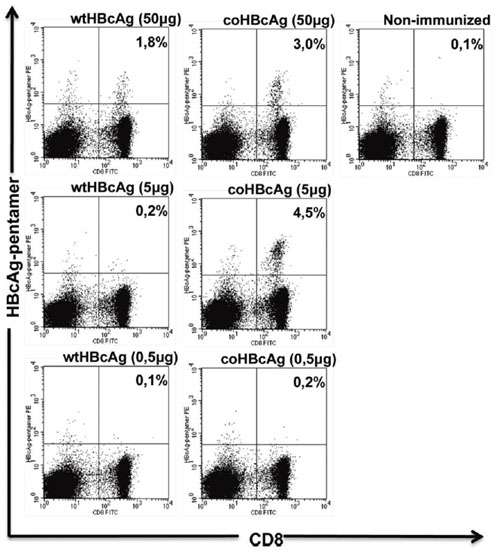Your basket is currently empty!
Pentamer-central-to-Hepatitis
Case Study:
Pro5® Pentamer central to Hepatitis B vaccine research
|
Lars Frelin, Karolinska Institutet, Sweden |
Nyström, J. et al. (2010). Improving on the ability of endogenous Hepatitis B Core Antigen to prime cytotoxic T lymphocytes. The Journal of Infectious Diseases. 201(12): 1867-1879. [PubMed ID 20446851]
In hepatitis B infection, the hepatitis B core antigen (HBcAg) is thought to be a major target for specific cytotoxic T cells (CTLs), making it an attractive candidate for therapeutic vaccine development. Nyström et al tested the ability of endogenous HBcAg to prime CTLs, and found it to be surprisingly inefficient. They set out to improve CTL priming by HBcAg, manipulating both codon usage and antigen delivery method. The use of a ProImmune custom Pro5® MHC Pentamer was central to the study. The H-2Kb/MGLKFRQL Pentamer, specific for the HBcAg(93-100) epitope, was used to detect and monitor HBcAg-specific CTL in immunized mice by flow cytometry. |
The team made use of a transient transgenic mouse model in which HBcAg is expressed by hepatocytes. In this model, clearance of the antigen-expressing cells is dependent on CD8+ CTLs. Using a Chromium release cytotoxicity assay, it was shown that HBcAg DNA delivered via intramuscular injection can prime functional CTLs in vivo, and that this causes elimination of the antigen-expressing hepatocytes. This result led to the conclusion that intramuscular injection of HBcAg DNA represents a viable strategy for therapeutic vaccination.
Further work, demonstrated that the CTL response was improved by codon optimization of the injected DNA, and by in vivo electroporation of injected DNA. HBcAg-specific CTLs generated in response to injection of increasing amounts of antigen were quantified using the MGLKFRQL Pro5® Pentamer (figure 1).

Figure 1: Codon optimization improves the ability of hepatitis B virus core antigen (HBcAg) DNA to prime high frequencies of HBcAg-specific cytotoxic T lymphocytes (CTLs), when delivered at high doses by in vivo electroporation, as determined by Pentamer staining. C57BL/6 mice (n=5 per group) were primed once with 50, 5, or 0.5 ug of codon-optimized HBcAg (coHBcAg) or wild-type HBcAg (wtHBcAg) DNA, and HBcAg-specific CTLs were determined 14 days later using Pentamer staining. Values are given as percentages of HBcAg-specific CD8+ T cells. © 2010 by the Infectious Diseases Society of America. All rights reserved.
Using this method of analysis, Nyström et al showed that high gene doses, of the order of 5ug of injected DNA, are required to effectively prime HBcAg-specific CTL responses. However at low doses (0.5ug), no discernable Pentamer signal was observed, even though similar experiments with hepatitis C virus non-structural 3/4 A DNA show strong responses at this concentration.
These results led to the conclusion that HBcAg is a relatively poor immunogen. The new data presented here on the performance of HBcAg in priming CTLs will be invaluable to the design and development of vaccine strategies for hepatitis B virus.

